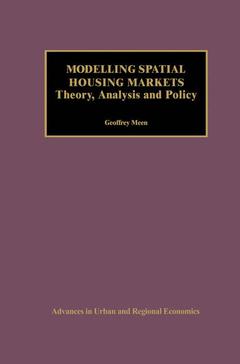Modelling Spatial Housing Markets, 2001 Theory, Analysis and Policy Advances in Urban and Regional Economics Series, Vol. 2

A second major theme is disaggregation, not only in terms of space, but also between households. The book argues that aggregate time-series models of housing markets of the type widely used in Britain and also in other countries in the past have become less relevant in a world of increasing income dispersion. Typically, aggregate relationships will break down, except under special conditions. We can no longer assume that traditional location or tenure patterns, for example, will continue in the future.
The book has four main components. First, it discusses trends in housing markets both internationally and within nations. Second, the book develops theoretical housing models at each spatial scale, starting with national models, moving down to the regional level and, then, to urban models. Third, the book provides empirical estimates of the models and, finally, the models are used for policy analysis. Analysis ranges over a wide variety of topics, including explanations for differing international house price trends, the causes of housing cycles, the role of credit markets, regional housing market interactions and the role of housing in urban/suburban population drift.
Date de parution : 10-2012
Ouvrage de 267 p.
15.5x23.5 cm
Disponible chez l'éditeur (délai d'approvisionnement : 15 jours).
Prix indicatif 158,24 €
Ajouter au panierDate de parution : 02-2001
Ouvrage de 267 p.
15.5x23.5 cm
Thème de Modelling Spatial Housing Markets :
Mots-clés :
USA; consumer; data analysis; econometrics; economy; growth; modeling; monetary policy; monetary union; population; science and technology; service; trends; unemployment; value-at-risk


